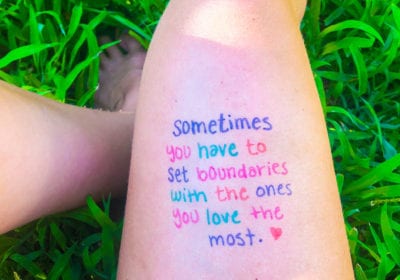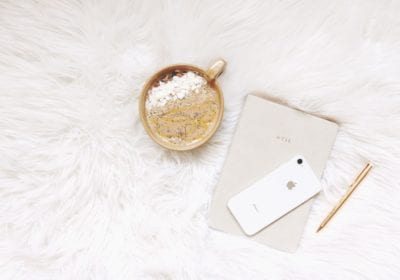
If you want to build a personalized wellness plan to manage your anxiety, a practical and straightforward way to get started is through keeping an anxiety tracker and wellness journal.
Although anxiety can feel similar to many of us, our triggers and treatment plans are as vastly different as we are as people. The unique combination that works for me is most likely not going to work for you.
Just how distinct plants thrive in diverse environments, each person requires various inputs to succeed with a reasonable anxiety level.
When attempting to build a mental health focused wellness plan, it can quickly become overwhelming. There are numerous options to explore: herbs, supplements, exercise, yoga, meditation, breathing techniques, therapy, and gratitude journaling. That list is only a small sampling of all the available natural methods. It can be frustrating, at best, to know where to get started!
By tracking your anxiety alongside wellness techniques, you can steadily begin to decipher what works best for you. After a few weeks, you can use this data to set wellness goals and start to create a routine that fits your specific needs.
Why track your anxiety?
Anxiety can come in waves or can be a constant underlying tone within every event. Regardless of how you experience anxiety, you can learn impactful lessons from tracking your triggers and wellness habits. A journal that takes as simple as 5 minutes to complete each day can provide insights into your daily happenings that you may otherwise overlook.
Anxiety has a way of taking us down the rabbit hole into an abyss of thought and worry. Getting lost in thinking can not only be frustrating but sucks down hours with little to no memory of the reality of the day.
To slowly climb out of the rabbit hole, it is pertinent to understand what methods help you or alternately push you deeper into the dark. How do you figure that out…you track it, test it, and set goals!
By carefully observing what habits work well, you can begin to construct a routine that guides you through a once-complicated ecosystem.
How to get started…
Taking the first step is always the hardest part. Once you get into the routine of journaling, it becomes just another standard step to complete with the remainder of your daily habits.
Wellness is an active process of growing and developing into the best you. To get a solid foundation of information, I would suggest keeping a journal for at least four weeks for the anxiety baseline and whipping out the journal when you want to try out new approaches.
What do you need?
A journal and pen OR the notes app in your cell phone OR use a guide that is specifically designed to track anxiety and build wellness goals.
How long to journal?
5 minutes, highlighting a few key components listed in the “What to Journal?” section
How often to journal?
Once a day, at a time that works best from you. The most effective time may be right before bed, as you have completed all of your wellness habits but still have your daily anxiety levels/triggers fresh in your mind.
Anxiety Tracker and Wellness Journal Outline
To gather useful data to analyze, keep track of a few essential pieces of information to review every month, or whenever you want to dissect a new habit. This information will help you stay on track and get valuable feedback to design an optimal wellness routine.
1. Anxiety Level (with explanation)
Select a value daily that best describes the level of anxiety you felt throughout the day. Then explain that level with quick fragmented sentences of the highlights of your day.
Examples of level scale:
- LOW – calm
- LOW TO MEDIUM – mostly calm with some anxiety
- MEDIUM TO LOW – average with calm moments
- MEDIUM – average anxiety
- MEDIUM TO HIGH – average with peak moments
- HIGH TO MEDIUM -high with average moments
- HIGH – max anxiety
Example of explanation:
Calmer with my coworkers, less easily irritated, considerable expense without spending stress, slight anxiety about friend’s judgment but overall low anxiety
2. Supplements
List all things that you consumed to supplement your health.
Examples of supplements:
- Lavender Tea
- Vitamin B
- Magnesium
- Ashwagandha
- Turmeric
- Ylang Ylang Essential Oil
- Kombucha
3. Self Care
List all actions you took to take care of yourself.
Examples of self care
- Exercise
- Breathing Exercises
- Meditation
- Talking with Friends
- Walking your dog
- Getting Outside
- Taking a Bath
4. Diet
List what you ate and drank during the day.
Examples of diet:
- Eggs
- Spinach
- Coffee
- Turkey
- Broccoli
- Nuts
- Black Beans
Use the Anxiety Tracker to Set Goals
Setting goals for mental health is just as important (if not more important) as setting quarterly goals at work or fitness goals in the gym. Journaling your anxiety and wellness techniques allow you to pull from an abundant source of information to make informed goals.
These goals can then be broken down into measurable and attainable steps. Each step building on one another until you can custom design a wellness routine that can be easily maintained. These actions make a once daunting task of managing your anxiety become as simple as any other daily habit.
A Purpose-Built Anxiety Tracker and Goal Setting Guide
After struggling to find a wellness plan that fit my specific anxiety needs, I decided to develop one on my own. Like any scientist, I knew that I first would need to collect select data to analyze and derive answers from.
So, I created a set of data points to record each day, and at the end of 6 weeks, I reviewed. What set me off course? What caused the most anxiety? When was I the calmest and what did I do differently?
The journal acted as a guide, which further allowed me to design specific goals and routines for my lifestyle. Taking this step as a deep dive into my current processes and explore new processes, was a pivotal moment in my wellness journey with anxiety. So much so, that I created the exact guide I used to provide you with tools for the same groundbreaking change.



